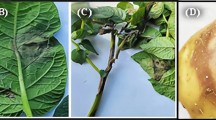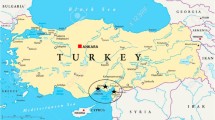Abstract
Late blight, caused by Phytophthora infestans (Mont.) de Bary, is a devastating disease found worldwide. During 2011, 2013 and 2014 cropping seasons, prevalence of potato late blight in all survived areas throughout the interior of Syria was examined and the disease incidence varied and ranged from 0 to 85.71%. Potato leave samples showing late blight symptoms were collected from five different regions known to grow potato intensively. Based on their morphological characteristics, 22 isolates were distinguished as P. infestans. Using two fungal specific primers, ITS3 and PINF2 in a PCR assay, all isolates were confirmed as P. infestans, while they produce ~ 450 bp band. Similarly, all confirmed P. infestans isolates were able to produce a 170-bp band when INF-1 and INF-2 primers were deployed indicating that studied isolates had merely mating type A1 and no isolate with mating type A2 was found which might explain the absence of oospores in considered areas.


Similar content being viewed by others
References
Andersson B, SandstroÈm M, StroÈmberg A (1998) Indications of soil borne inoculum of Phytophthora infestans. Potato Res 41:305–310
Andrivon D (1995) Biology, ecology and epidemiology of the potato late blight pathogen Phytophthora infestans in soil. Phytopathology 85:1053–1056
Avendaño Córcoles J (2007) Survey of Phytophthora infestans population in Austria based on phenotypic and molecular markers. Ph.D. Thesis, University of Natural Resources and Applied Life Sciences, Vienna, Austria
Bakonyi J, Láday M, Dula T, Érsek T (2002) Characterization of isolates of Phytophthora infestans from Hungary. Eur J Plant Pathol 108:139–146
Chmielarz M, Sobkowiak S, Debski K, Cooke DEL, Brurberg MB, Sliwka J (2014) Diversity of Phytophthora infestans from Poland. Plant Pathol 63:203–211
Cooke DEL, Schena L, Cacciola SO (2007) Tools to detect, identify and monitor Phytophthora species in natural ecosystems. J Plant Pathol 89:13–28
Drenth A, Tas ICQ, Govers F (1994) DNA fingerprinting uncovers a new sexually reproducing population of Phytophthora infestans in the Netherlands. Eur J Plant Pathol 100:97–107
Drenth A, Janssen EM, Govers F (1995) Formation and survival of oospores of Phytophthora infestans under natural conditions. Plant Pathol 44:86–94
Erwin DC, Ribero OK (1998) Phytophthora diseases worldwide. Plant Pathol 47:224–226
Fry WE, Goodwin SB (1997) Re-emergence of potato and tomato late blight in the United States and Canada. Plant Dis 81:1349–1357
Fry WE, Goodwin SB, Dyer AT, Matuszak JM, Drenth A, Tooley PW, Sujkowski LS, Koh YJ, Cohen BA, Spielman LJ, Deahl KL, Inglis DA, Sandlan KP (1993) Historical and recent migrations of Phytophthora infestans: chronology, pathways and implications. Plant Dis 77:653–661
Haverkort AJ, Struik PC, Visser RGF, Jacobsen E (2009) Applied biotechnology to combat late blight in potato caused by Phytophthora infestans. Potato Res 52:249–264
Hermansen A, Hannukkala A, Naerstad RH, Brurberg MB (2000) Variation in populations of Phytophthora infestans in Finland and Norway: mating type, metalaxyl resistance and virulence phenotype. Plant Pathol 49:11–22
Hussain S, Lees AK, Duncan JM, Cooke DEL (2005) Development of a species-specific and sensitive detection assay for Phytophthora infestans and its application for monitoring of inoculum in tubers and soil. Plant Pathol 54:373–382
Jaime-Garcia R, Orum TV, Felix-Gastelum R, Trinidad-Correa R, Vanetten HD, Nelson MR (2001) Spatial analysis of Phytophthora infestans genotypes and late blight severity on tomato and potato in the Del Fuerte Valley using geostatistics and geographic information systems. Phytopathology 91:1156–1165
Jmour W, Hamada W (2006) First report of A2 mating type of Phytophthora infestans in Tunisia using molecular markers and some observations on its metalaxyl resistance. Tunis J Plant Prot 1:85–91
Judelson HS, Tooley PW (2000) Enhanced polymerase chain reaction methods for detecting and quantifying Phytophthora infestans in plants. Phytopathology 90:1112–1119
Jyan MH, Huang LC, Ann PJ, Liou RF (2002) Rapid detection of Phytophthora infestans by PCR. Plant Pathol Bull 11:25–32
Kirk WW, Samen F, Abu El, Wharton P, Douches D, Tumbalam P, Thill C, Thompson A (2009) Impact of different US genotypes of Phytophthora infestans on potato seed tuber rot and plant emergence in a range of cultivars and advanced breeding lines. Potato Res 51:121–140
Lehtinen A, Hannukkala A, Andersson B, Hermansen A, Le VH, Nærstad R, Brurberg MB, Nielsen BJ, Hansen JG, Yuen J (2007) Phenotypic variation in Nordic populations of Phytophthora infestans in 2003. Plant Pathol 57:227–234
Lepoivre P (2003) Phytopathology. De Boeck, Bruxelles
Mazáková J, Táborský V, Zouhar M, Ryšánek P, Hausvater E, Doležal P (2006) Occurrence and distribution of mating types A1 and A2 of Phytophthora infestans (Mont.) de Bary in the Czech Republic. Plant Prot Sci 42:41–48
Moller K, Dilger M, Habermeyer J, Zinkernagel V, Flier WG, Hausladen H (2009) Population studies on Phytophthora infestans on potatoes and tomatoes in southern Germany. Eur J Plant Pathol 124:659–672
Mukalazi J, Adipala E, Sengooba T (2000) Population structure of Phytophthora infestans in Uganda. Crop Prot (Natrass RM, Ryan M (1951) New hosts of Phytophthora infestans in Kenya. Nature 168:85–86)
Murray MG, Thompson WF (1980) Rapid isolation of high molecular weight plant DNA. Nucleic Acids Res 10:4321–4325
Nowicki N (2012) Potato and tomato late blight caused by Phytophthora infestans: an overview of pathology and resistance breeding. Plant Dis 96:4–17
Olanya MO, Ojiambo PS, Nyankanga RO, Honeycutt CW, Kirk WW (2009) Recent developments in managing tuber blight of potato (Solanum tuberosum) caused by Phytophthora infestans. Can J Plant Path 31:280–289
Pittis JE, Shattock RC (1994) Viability germination and infection potential of oospores of Phytophthora infestans. Plant Pathol 43:387–396
Ramelli EG, Villegas JS, Reynaldi S (2009) Efecto sobre la sarna polvosa de cuatro aislamientos del hongo Trichoderma asperellum en tres tipos de suelo. En: Colombia Revista Facultad Nacional De Agronomía - Medellín ISSN: 0304-2847, ed: Universidad Nacional de Colombia v.62 fasc.1, pp 4783–4792
Runno-Paurson E, Remmel T, Koppel M, Tähtjärv T (2010) Occurrence and distribution mating types A1 and A2 of Phytophthora infestans in eastern Estonia. Agron Res 8(Special Issue II):471–474
Śliwka J, Sobkowiak S, Lebecka R, Avendaño-Córcoles J, Zimnoch-Guzowska E (2006) Mating type, virulence, aggressiveness and metalaxyl resistance of isolates of Phytophthora infestans in Poland. Potato Res 49:155–166
Tooley PW, Bunyard BA, Carras MM, Hatziloukas E (1997) Development of PCR primers from internal transcribed spacer region 2 for the detection of Phytophthora species infecting potatoes. Appl Environ Microbiol 63:1467–1475
Tosun N, Yildirim A, Turkusay H, Tanyolac B (2007) Genetic variation among Phytophthora infestans (tomato blight) isolates from western Turkey revealed by inter simple sequence repeat (ISSR) and random amplified polymorphic DNA (RAPD) markers. Pak J Bot 39(3):897–902
Trout CL, Ristaino JB, Madritch M, Wangsomboondee T (1997) Rapid detection of Phytophthora infestansin late blight-infected potato and tomato using PCR. Plant Dis 81:1042–1048
Zwankhuizen MJ, Govers F, Zadoks JC (2000) Inoculum sources and genotypic diversity of Phytophthora infestans in Southern Flevoland, the Netherlands. Eur J Plant Pathol 106:667–680
Acknowledgements
The authors would like to thank the Director General of the Atomic Energy Commission of Syria and the head of the Molecular Biology and Biotechnology department for their continuous support throughout this work.
Author information
Authors and Affiliations
Corresponding author
Ethics declarations
Conflict of interest
Walid Naffaa, on behalf of the co-authors, we have no conflict of interest.
Rights and permissions
About this article
Cite this article
Naffaa, W., Ibrahim, S., Abou Alfadil, T. et al. Incidence of the potato late blight pathogen, Phytophthora infestans, in Syria and its mating type. J Plant Dis Prot 124, 533–537 (2017). https://doi.org/10.1007/s41348-017-0130-8
Received:
Accepted:
Published:
Issue Date:
DOI: https://doi.org/10.1007/s41348-017-0130-8




